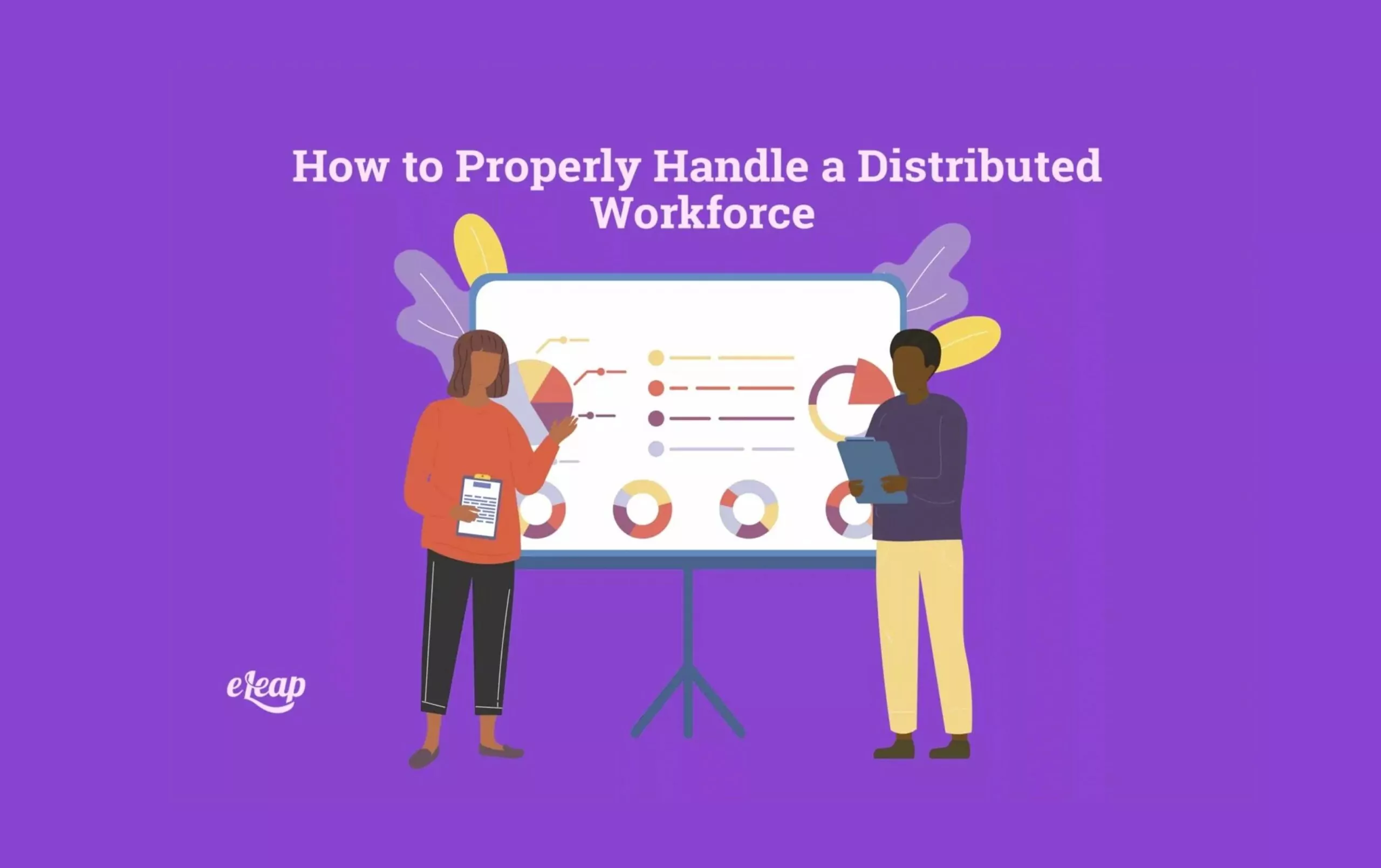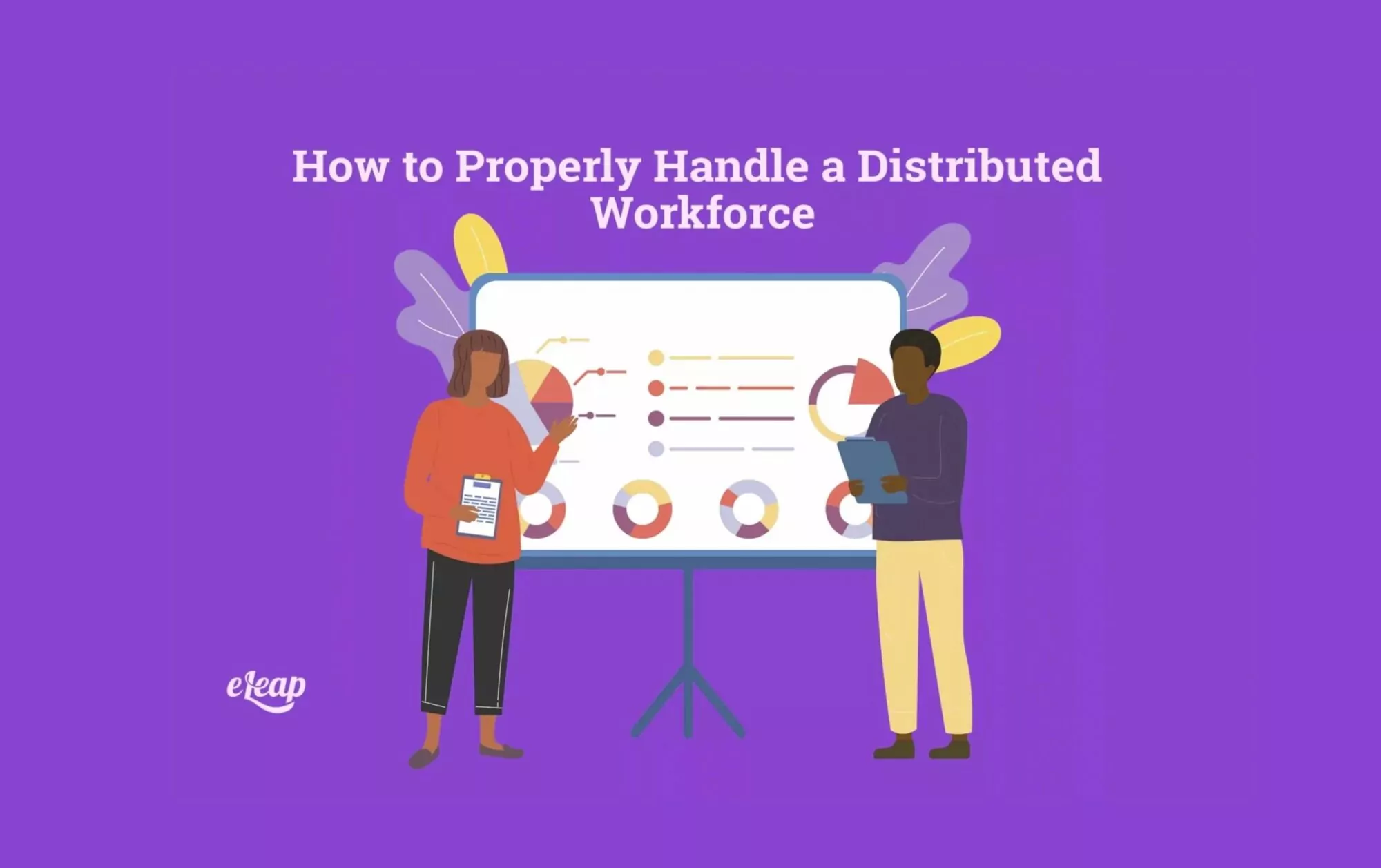How to Properly Handle a Distributed Workforce

While it used to be most common for your team to be under one roof 40 hours a week, having a distributed workforce is becoming much more normal. Between the advances in technology and navigating workspaces during a global pandemic, companies all over have become more flexible about where their employees work daily.
Being able to work from anywhere allows for opportunities to come up that were never there when all of your employees had to be together. However, having a distributed workforce comes with its own set of challenges. One of the biggest ones is employee engagement.

Being able to keep your employees engaged from home or even states away is a crucial part of being able to properly manage your distributed workforce. Our goal with this article is to give you tips on how to do just that! When you have engaged employees, your distributed workforce can accomplish more than you ever thought possible!
Benefits of Having a Distributed Workforce
When employers needed creative ways to allow their employees to work from anywhere during the spring of 2020, there was a lot of concern. However, many companies found that allowing their employees to work remotely came with many benefits. Whether your team works from different areas or at different times, you’ve likely experienced some of them yourself!
One of the biggest benefits of utilizing a distributed workforce is that productivity tends to skyrocket. Almost every employee you ask will say they’re more productive when working remotely versus having to go into the office. When your employees are productive, they meet deadlines and exceed goals!
Plus, choosing to allow your employees to work from home allows your company to save money. Without needing as large of an office space, or an office at all, you’re able to save on rent and utilities. Not to mention saving on basic supplies like paper and pens. Add that to increased productivity and your profit margin is likely to be impressive!
Employees also tend to be happier overall when they’re able to work remotely. When you have happy employees, you have a lower turnover rate which means higher retention. Many employees have the newfound desire to work from home for the rest of their professional lives, which makes allowing remote work a huge incentive!
Of course, all of these elements are true of any successfully run distributed workforce. To see these benefits, you have to be able to actively engage your employees regularly. It’s even more crucial to develop a good work culture when you aren’t able to communicate in person regularly.
Difficulties of Having a Distributed Workforce
It’s no secret that workplace culture is something that’s been a challenge for companies everywhere for many years. As the focus on better work-life balance, fair treatment, and engagement become the most important elements people look for, this becomes even more evident. Of course, if your team is across states or schedules, the challenge is even more present.
Keeping your employees engaged while on the clock is crucial to having a successful team. But how do you do that? There are many opinions on the best way to engage your employees but they each come with their own challenges.
Giving your employees flexibility for when and where they work is one of the most successful ways you can help make sure they’re engaged. However, when you use flexibility, some serious complications can show up.
Consider the common complications of a typical workday in your office. When addressing misunderstandings, how much harder would it be without seeing someone’s facial expressions or hearing their tone? It can be next to impossible to keep everyone on the same page when they’re working remotely.
Only about one percent of employees feel like their distributed team is working together and communicating as they should. With breakdowns in this area, it can lead to unnecessary tension, frustrations, and burnout with your employees – and you may never know about it unless you ask.
Elements of Engagement
As the manager of a distributed workforce, it’s your job to make sure your employees can engage with one another and you in an effective way. Let’s look at some of the areas that affect employee engagement.
Create Bonds
When your employees form friendships at work, they’re more likely to be productive and engaged in their daily tasks. Not being able to do this is one of the biggest issues with employee engagement across the board.
Now, consider how hard it is to develop these relationships when you never see your coworkers in person. When your team is looking for connections, it’s crucial that they have a way to make them.
Finding Daily Purpose
Jobs can become mundane in all settings. However, with a lack of people interaction, remote workers are likely to have an even harder time finding their daily motivation. When they can, you’ll see impressive productivity!
Your employees want to know that the work they’re doing is making a difference for someone. They need to know that what they’re doing matters. While harder with a distributed workforce, it’s crucial that you find ways to show them this if you want increased engagement.
The Driving Forces of Engagement
If you want to know what your employees are looking for when it comes to engagement, it comes down to a few elements. Overall, most employees desire three main things for them at work to feel like they can be productive.
Those three things are:
- Purpose: They want to know that their work is making a difference
- Safety: They want to work without fear of negative repercussions
- Capacity: They want to have access to the resources they need
From there, other elements come into play to create an engaging environment. Each employee is likely to have their own feelings on which ones are most important to them, but there are some common elements remote teams are looking for, including:
- Friendship
- Feedback
- Utilization
- Shared Values
- Trust
- Role Clarity
Get Feedback to Succeed
With the information you’ve learned so far, you may be wondering what your distributed workforce is looking for. There’s one guaranteed way to learn: get their feedback.
It’s completely possible to have your scattered team engaged while working remotely. However, in order to do so, you need to measure the engagement and learn what your employees are looking for.
Your best option with a distributed workforce is to start out by asking for anonymous feedback. Send out a survey with specific questions so you can gauge the current engagement and overall happiness of your team in a variety of areas. When the feedback is anonymous, your employees are more likely to be genuine with their responses.
Once you’ve received the feedback results, you can look for trends and problem areas that your team has highlighted. This helps you see what areas your employees are needing extra support so that you have a truly engaging culture.
Everyone’s culture is likely to need different things and there isn’t one easy fix that works for every company. However, every company can benefit from asking their employees what they need in order to feel more engaged at work.
With a distributed workforce, there are extra elements to consider when evaluating the feedback results. Look for trends in managers, teams, locations, or shifts. When you look for these common denominators, you may find that there’s one location or team that is struggling more than others.
If you’re able to identify a specific group of employees that aren’t engaged, that can become the focal point for your efforts to improve the overall engagement of your company.
It’s important for every company to consider employee engagement but it’s crucial if you have a distributed workforce. When you receive feedback, you can become aware of issues that there’s no other way for you to have known about. Plus, taking the time to get feedback from employees who are working remotely can help them feel like they still matter, even if they’re not surrounded by colleagues.
Feedback should be a continuing element of handling your workforce as well. You should be in a constant cycle of gathering and using feedback:
- Get feedback
- Look for trends
- Find the underlying issues
- Take action to correct problems
- Repeat
Takeaway
Having a distributed workforce comes with its own set of unique benefits and challenges. When handled correctly, having the flexibility of where and when employees can work has proven to help with productivity.
However, productivity is important but not the only element of a successful team. Make sure to take time to keep your distributed team engaged. Always be proactive in finding areas where your virtual work culture can improve. When you make this a priority, your distributed workforce is much more likely to be engaged.
Distributed workforces are the way of the future. However, it’s important that you continue to cultivate a healthy work environment no matter where your employees are located. Though there will be challenges along the way, the benefits will outweigh them when you engage your employees effectively!
The eLeaP continuous performance management system provides organizations with powerful options to attract and retain high caliber team members.